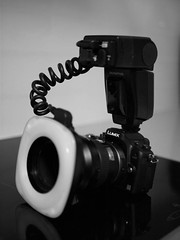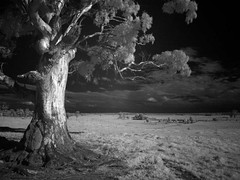Olympus and Panasonic have just announced a new camera system with interchangeable lenses based on the existing Four Thirds sensor size but without a reflex mirror.
see more information and links here
This is very exciting news for a number of reasons.
The removal of the mirror will have some downsides compared with digital SLRs such as loss of dSLR AF speed, reliance on electronic viewfinder or a non-SLR rangefinder type optical viewfinder.
BUT the loss of the mirror brings a multitude of other possibilities whilst retaining the image quality of a relatively large image sensor (well larger than most non-dSLR cameras) AND the ability to use almost any lens ever made via adapters (including existing Four Thirds Olympus/Leica/Panasonic/Sigma lenses in AF, but also legacy Olympus OM, Nikon F, Carl Zeiss, Leica R or M lenses in manual focus only mode).
We will now see a convergence of current point and shoot digitals with video cameras and dSLR systems which will allow some really cool possibilities such as:
A high quality slim compact take anywhere camera that can be extended as needed by changing lenses. Such a camera would make a very nice back up camera to your main dSLR camera and would potentially even be considered by fussy “cool” adolescents who refuse to use dSLRs because of their bulk.
A Leica M-like silent optical rangefinder with compact wide angle lens for those candid photographers.
A dSLR quality camera that could shoot at 1200 frames a second silently in a similar way that the current Casio EX-F1 but with ability to use any lens and at higher image quality. If you haven’t seen the possibilities of 1200fps SLO-MO image capture then check this site out.
A slim, compact, silent camera to which you can attach a high quality wide aperture telephoto (eg. 150mm f/2 to give equivalent of 300mm f/2.0 in 35mm terms) and take either stills or movies in silence of your daughter’s classical music concert without causing annoying noises or having to be so close that you are distracting.
A slim, compact, silent camera for which new high performance compact, light lenses can be made never before seen at that image quality and size. Certainly the design of ultra wide angle lenses can be simplified with this design and we could expect some very interesting lenses in both ultra wide and lenses with large zoom ranges in the telephoto end.
Potentially, a dedicated astrophotography camera which has no need to lock mirror up and is light enough it doesn’t adversely affect telescope balance, and having a very short sensor to flange distance that it will be able to focus at infinity on Newtonian telescopes that can’t do so on normal dSLRs.
I can see lots of possibilities with this development, and I’m looking forward to seeing how Olympus, Panasonic & Leica proceed.










